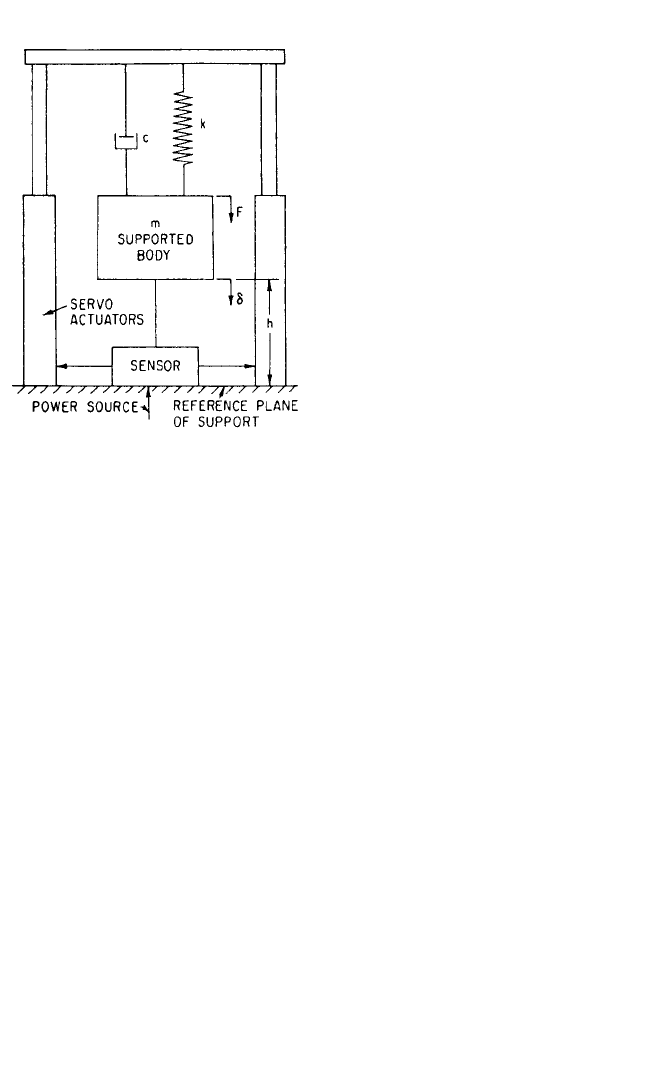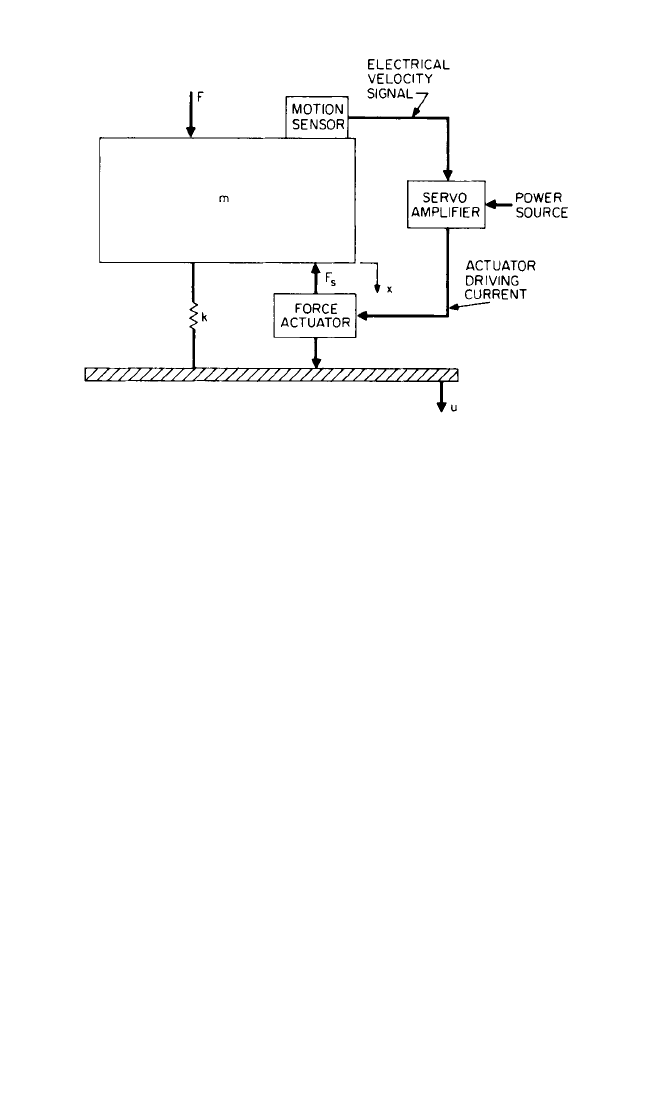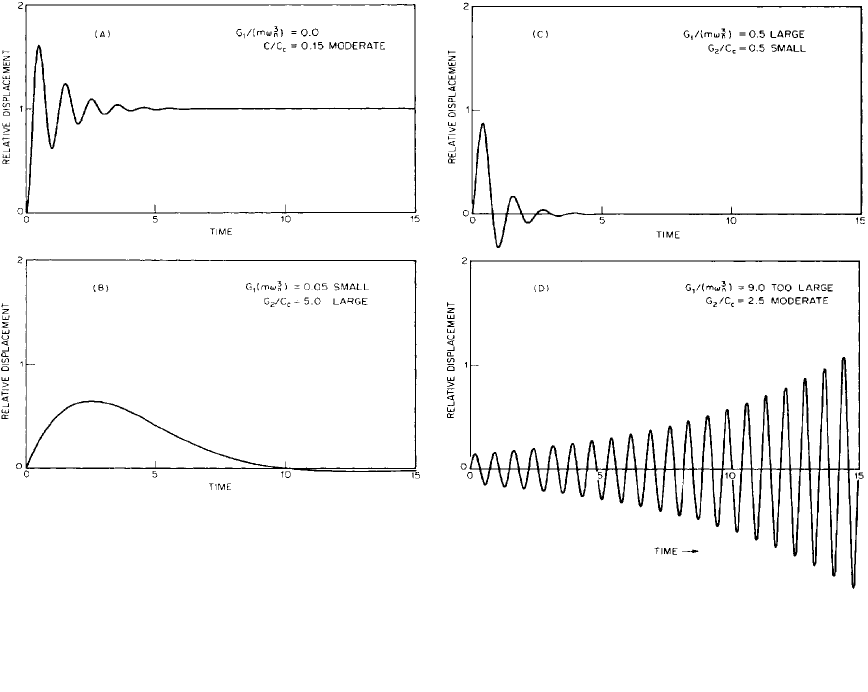Harris C.M., Piersol A.G. Harris Shock and vibration handbook
Подождите немного. Документ загружается.


tem and the specific environment in which the system will operate. Extraneous
requirements cause needless complications. For example, if the vibration level is an
acceleration of +1g, it is not advisable to specify +2g to be safe. Likewise, it is inad-
visable to rigidly apply an entire specification to an isolator installation when only a
small part of the specification is applicable.
Typically, specifications to which vibration and shock isolators are designed will
include requirements regarding (1) vibration amplitudes, (2) shock amplitudes, (3)
load to be carried, (4) required protection for equipment, (5) temperatures to be
encountered (environmental factors, in general), and (6) steady acceleration loads
superimposed on dynamic loading.
ACTIVE VIBRATION CONTROL SYSTEMS
The preceding sections of this chapter consider only passive vibration control sys-
tems and their components; active vibration control systems differ significantly from
such conventional vibration control systems. An active vibration control system is a
system in which one or more sensors is required to measure the absolute value or
change in a physical quantity (such as position, motion, temperature, etc.); then such
a change is converted to a signal used to modify the behavior of the system. Such
modification requires the addition of external power, in contrast to a conventional
(passive) vibration control system which does not require the addition of external
power or the use of sensors. But in special cases, these additional complications,
required in an active vibration control system, may be outweighed by benefits that
can otherwise not be obtained with a conventional system, as illustrated in the fol-
lowing examples.
AN ACTIVE SYSTEM FOR RESILIENTLY SUPPORTING A BODY AT
GIVEN POSITION DESPITE VARIATIONS IN THE APPLIED LOAD
Consider the active vibration control system shown in Fig. 32.20. A mass m is sup-
ported by a spring of stiffness k, with a damping coefficient c. Force F is slowly
applied to the mass, as illustrated, causing the spring to stretch, resulting in a down-
ward displacement δ of the mass. A sensor responds to the displacement, causing it
to generate a signal proportional to the relative motion of the system. As a result,
power is supplied by a servo-controlled motor that moves the supporting frame
upward until the body returns to its original position with respect to the supporting
plane. This active vibration control system thus maintains the supported body in its
equilibrium position, despite the applied load, until another change in the force
occurs. Thus there is zero displacement of the mass in the presence of a constant
force F. This is a type of negative feedback regulation, so called because the servo-
controlled motor applies a “feedback” force to the supported body which opposes
its movement.A feedback control system is a system in which the value of some out-
put quantity is controlled by feeding back the value of the controlled quantity and
using it to manipulate an input quantity to bring the controlled quantity closer to the
desired value. (In contrast, a feedforward control system is a system in which changes
are detected at the process input, and anticipating correction is made before the
process output is affected.)
The active vibration isolation system illustrated in Fig. 32.20 seeks as its equilib-
rium position a location at a distance h above the reference lane of the support, inde-
SHOCK AND VIBRATION ISOLATORS AND ISOLATION SYSTEMS 32.29
8434_Harris_32_b.qxd 09/20/2001 12:32 PM Page 32.29

pendent of the origin and magnitude of
a steady force applied to the supported
body. While there is no change in the
position of the body in response to a
very slowly applied load, if the applied
load is suddenly removed, the servo-
mechanism (providing the regulation)
may be unable to respond fast enough to
compensate for the tendency of the sup-
ported body to change position relative
to the support; then the isolator can
experience a significant deflection.
This example demonstrates that
where the damped natural frequency of
the isolation system must be relatively
low, with the additional requirement
that the supported body be maintained
at a relatively constant distance from the
base to which it is attached, the applica-
tion of an active vibration control sys-
tem may be of considerable benefit.
Controller Gain; Integral Control; Pro-
portional Control. The computational
element for the elimination of the isola-
tor static deflection is that of an integra-
tor and scaling term called a controller
gain. This combination of sensing, computation, and actuation provides what is
known as integral control, since the feedback force is proportional to the time inte-
gral of the sensor response. The computational elements for the control of the sys-
tem resonance and low-frequency vibration isolation require only a scaling term.
This combination of control elements is called proportional control, since the feed-
back force is proportional to the sensor response. The feedback elements added to a
conventional isolation system must have an overall characteristic such that the out-
put force is proportional to the sensed function times the control function of the
computational element. The control function describes the operation of the compu-
tational element, which can be a simple constant as in proportional control, an inte-
gration function as in integral control, or an equation describing the action of one or
more electric circuits. This corresponds to a spring which provides an output force
proportional to the deflection of the spring, a viscous damper which provides a force
proportional to the rate of deflection of the damper, or an electric circuit which pro-
duces a force signal proportional to the dynamics of a spring and viscous damper, in
series, undergoing a motion proportional to the sensor response.
The sensing and actuation devices which provide integral control of the isolator
relative displacement may take many forms. For example, the sensing element which
measures the position of the supported body (relative to the reference plane of the
support) may be a differential transformer which produces an electrical signal pro-
portional to its extension relative to a neutral position. The sensing element is
attached at one end to the supported body and at the other end to the isolator sup-
port structure in a manner such that the sensor is in its neutral position when the
supported body is at its desired operating height. The electrical signal is integrated
and amplified in the computational element, providing electric power to operate an
32.30 CHAPTER THIRTY-TWO
FIGURE 32.20 Schematic diagram of an
active vibration-isolation system which main-
tains the supported body m a fixed distance h
from the reference plane of the support, irre-
spective of the steady force F applied to the sup-
ported body.
8434_Harris_32_b.qxd 09/20/2001 12:32 PM Page 32.30

electric motor actuation device. The differential transformer-integrator-motor sys-
tem produces a force proportional to the integral of the signal from the differential
transformer. The operation of this servomechanism can be visualized in the follow-
ing manner:
1. A force F of constant magnitude F
0
is applied to the supported body, causing a
relative deflection of the isolator spring element.
2. The sensing element (in this case a differential transformer) applies an electrical
signal that is proportional to the isolator relative displacement to the integration
and scaling functions in the computational element.
3. The response of the computational integration function generates an electrical
signal that continues to increase in magnitude so long as the relative displace-
ment δ is not zero.
4. The signal from the computational element is applied to the motor element,
which generates a force in a direction that decreases the isolator deflection; the
motor force follows the computational element signal and continues to increase
in magnitude so long as the relative deflection δ is not zero.
5. At some point in time the force from the motor output will exactly equal the con-
stant force F
0
, requiring a relative displacement of zero.
6. The output from the differential transformer is zero; thus the output from the
computational element integration function no longer increases but is main-
tained constant at the magnitude required for the motor element to generate a
force exactly equal to the constant force F
0
applied to the supported body.
The isolation system remains in this equilibrium condition until the force applied
to the supported body changes and causes a nonzero signal to be generated by the
sensing element; then the process starts all over again. Alternatively, a proportion-
ally scaled signal from the differential transformer may be used to operate an
electromechanical servo valve, the flow response of the servo valve being propor-
tional to its excitation signal. The servo-valve fluid-flow output is directed into the
chamber of an air spring to produce the desired force applied to the supported body.
The control function remains integral in nature since the actuator’s internal pressure
responds to the volume output from the servo valve, which is the integral of its flow
output. Thus, in this case, no electrical integration of the sensor signal is needed. It is
also possible to operate a mechanical servo valve through a direct mechanical cou-
pling in such a way that the motion of the suspended body with respect to its support
is used directly to provide the required servo-valve actuation. The possible combi-
nations of elements and control devices are almost limitless.The choice of a suitable
combination of sensor, computation element, and actuator is dictated by the type of
power available, the supported body size, the weight, and the type of application,
e.g., spacecraft, aircraft, automotive, or industrial.
AN ACTIVE SYSTEM FOR CONTROLLING ITS SYSTEM
RESONANCE AND LOW-FREQUENCY VIBRATION ISOLATION
The mechanical system shown in Fig. 32.21 provides active control of its system res-
onance and the vibration isolation it provides at low frequencies. This system con-
sists of a velocity sensor (for example, see Chap. 12), a proportional computational
element, and a motor actuation device that also may take on many forms.The veloc-
SHOCK AND VIBRATION ISOLATORS AND ISOLATION SYSTEMS 32.31
8434_Harris_32_b.qxd 09/20/2001 12:32 PM Page 32.31

ity of the supported body may be sensed by an electromagnetic sensor which meas-
ures velocity directly, or it may be obtained by integrating the response of an
accelerometer. Figure 32.21 illustrates the elements of this servomechanism; the
servo amplifier contains the system electronic devices which form the computational
elements and the power elements required to operate the force actuator.The motor
element is contained partly in the servo amplifier and partly in the force actuator.
This shows that the three basic elements of a servomechanism are not always self-
contained devices, but may be made up of the combined operation of system hard-
ware components.The force actuator usually consists of an electrodynamic vibration
exciter similar to those described in Chap. 25. Electronic amplifiers which drive the
force motor must have a frequency response extending down to zero frequency, so
as not to introduce timing errors into the control signal that can significantly alter
the response of the servomechanism. The velocity sensor-amplifier-motor system
making up this servomechanism applies a force to the supported body that is pro-
portional to the body’s velocity and thus acts in the same manner as a viscous
damper connected to the supported body at one end and to motionless fixed space
at the other end.This produces a form of damping within the active vibration control
system which cannot be synthesized using passive damping elements alone. The
action of this velocity-controlled servomechanism is referred to as active damping,
and the active damping scaling term G
2
, relating the supported body velocity to the
force applied to the mass m, when divided by the critical damping term for the pas-
sive spring and mass elements 2
k
m
, is commonly referred to as the active fraction
of critical damping G
2
/c
c
.
An active vibration-isolation system usually is described by a cubic or higher-
order differential equation; because of the complexity of these equations, it is diffi-
cult to visualize the effect of changes in the system constants on the performance of
32.32 CHAPTER THIRTY-TWO
FIGURE 32.21 Schematic diagram of an active vibration control system
which acts like a passive vibration-isolation mass and spring element with a
viscous damping element connected between the supported body and
motionless fixed space. The active damping servomechanism can eliminate
the isolation system resonance, thereby providing vibration isolation start-
ing at zero frequency.
8434_Harris_32_b.qxd 09/20/2001 12:32 PM Page 32.32

the isolation system. This is particularly true when the actual nonideal response
characteristics of the system sensing, computational, and motor elements are
included in the system differential equation of motion and when additional compu-
tational elements, called compensation circuits, are added. The compensation cir-
cuits are used to alter the system frequency response, i.e., resonance frequency and
peak transmissibility. In working with active vibration control systems of the type
presented here, it is not uncommon to have differential equations as high as the
twelfth order or more. The field of automatic control system synthesis has devised
methods to deal with differential equations of such high orders from both a theoret-
ical analysis and an actual system hardware point of view.
Because integral feedback of displacement requires that energy be fed into the
control system, it is possible to make the active system dynamically unstable by
improper proportioning of its constants. An active vibration control system that is
dynamically unstable will undergo continuously increasing mechanical oscillations
which, when not limited by available power, will increase until the system is
destroyed. Therefore, one of the factors in achieving a satisfactory active vibration
control system is the determination of the margin of dynamic stability of the entire
system. Here too, the field of automatic control systems has devised methods to
establish the system margin of dynamic stability.The margin of dynamic stability is a
measure of the degree of change in system constants that is required for the active
vibration control system to become unstable.
In the case of a conventional passive vibration control system, it is possible to
determine many of the performance characteristics from the constants appearing in
the differential equation. For example, the transmissibility T of a conventional sys-
tem at the condition of resonance is approximately
T
r
= where c/c
c
< 0.2 (32.14)
Similarly, the resonance frequency ω
r
is approximately equal to the undamped natu-
ral frequency:
ω
r
where c/c
c
< 0.2 (32.15)
At high frequencies (ω>>ω
n
), the transmissibility of a conventional system ap-
proaches the asymptotic value
T
i
= where ω>>ω
n
(32.16)
The transmissibility curve of a conventional isolator may be estimated from Eqs.
(32.14) to (32.16) without plotting the transmissibility equation point by point.
Somewhat similar relationships can be obtained for an active system if its equation
of motion is not higher than the second order. A convenient way to obtain rules of
thumb for the design of an active vibration control system is to compare the charac-
teristic properties of a conventional vibration control system with those of the same
isolation system but with active elements which provide integral relative displace-
ment force feedback and proportional velocity force feedback added in parallel with
a spring isolation element. The velocity feedback gain G
2
generally has a larger
effect on the system response than the relative displacement gain term G
1
.The feed-
back gain terms relate the sensed system motion term to the force applied to the
supported body; therefore, the units of the velocity feedback gain term G
2
are the
c/c
c
ω/ω
n
k
m
1
2(c/c
c
)
k
m
c
SHOCK AND VIBRATION ISOLATORS AND ISOLATION SYSTEMS 32.33
8434_Harris_32_b.qxd 09/20/2001 12:32 PM Page 32.33

same as those for a viscous damper, or force per unit velocity; the gain term G
1
for
the integral relative displacement feedback has no passive counterpart and has units
of force per unit displacement multiplied by time. The active damping term domi-
nates the system differential equation, affecting the system response both above and
below the undamped natural frequency, while the effect of the relative displacement
feedback on system performance is confined mainly to the frequency region below
the undamped natural frequency. Setting the integral relative displacement gain
term G
1
to zero gives an approximation for the transmissibility of the active vibra-
tion control system:
T =
(32.17)
Using the above equation, the following response estimations can be formulated.
The system transmissibility T at a frequency equal to the undamped natural fre-
quency ω
n
, formed by the passive spring and mass elements k and m, is
T
n
= where ω=ω
n
(32.18)
The resonance frequency is less than the system undamped natural frequency, and
with an active fraction of critical damping term of 1 or larger, there is no system res-
onance; i.e., at all frequencies the system transmissibility is less than 1. In the case
where the relative displacement feedback gain is not zero, the mechanics of the sys-
tem must always form a resonance condition. At excitation frequencies well above
the system undamped natural frequency, the transmissibility of the active isolation
system approaches the asymptotic value
T
i
= (ω/ω
n
)
2
where ω>>ω
n
(32.19)
In the above response estimation relationship function, the system transmissibil-
ity at the undamped natural frequency is less than unity when the velocity feedback
gain exceeds a value giving an active fraction of critical damping of 0.5; i.e., G
2
/c
c
=
0.5.With an active fraction of critical damping of unity, the system transmissibility at
the undamped natural frequency is 0.5.Active vibration control systems of this type
typically exhibit velocity feedback gain magnitudes yielding an active fraction of
critical damping ranging from a low of about 0.5 to a high of about 5. The incorpo-
ration of the integral relative displacement feedback servomechanism in conjunc-
tion with the velocity feedback servomechanism and the passive system elements
forms a system described by a third-order differential equation. A resonance condi-
tion occurs well below the undamped natural frequency when the active fraction of
critical damping is 0.5 or more. The simplified response estimations of transmissibil-
ity are valid for frequencies at and above the system undamped natural frequency in
instances where the active fraction of critical damping is 0.5 or greater.As the active
fraction of critical damping is decreased, the resonance frequency approaches the
undamped natural frequency with an increasing peak transmissibility and an even-
tual dynamically unstable system.
In an ideal active vibration control system, the resonance frequency and peak
transmissibility are a function of the passive system constants and the two feedback
gain terms. In a nonideal active vibration control system, there are many other factors
that influence the system resonance characteristics, such as the low-frequency
response of the velocity sensor or a more complex passive system formed from many
mass and spring elements. The resonance characteristics of the active vibration con-
trol system are manipulated through compensation functions formed using electric
1
2G
2
/c
c
1
[1 − (ω/ω
n
)
2
]
2
+ [2(G
2
/c
c
)(ω/ω
n
)]
2
32.34 CHAPTER THIRTY-TWO
8434_Harris_32_b.qxd 09/20/2001 12:32 PM Page 32.34

networks in the computation element of the velocity servomechanism. The function
of these compensation networks is to alter the nature of the velocity feedback signal
applied to the motor element, in a manner that provides for a dynamically stable sys-
tem, and to raise or lower the resonance frequency, peak transmissibility, and trans-
missibility frequency response above the resonance frequency. The use of system
compensation circuitry is extensive in the field of automatic control system synthesis
as well as with active vibration control systems, which are a type of automatic control
system. The result of system compensation is active vibration control systems with
response characteristics similar but not limited to the response of the ideal system.
The analysis of the transient and frequency-response characteristics of an active
vibration control system having ideal elements shows many of the advantages of
actual active vibration control systems when compared to the response of passive sys-
tem elements alone.
In an active vibration control system, the element that provides integral control
of relative displacement strives to maintain the supported body at a constant dis-
tance from the support base to which it is attached. When a step function of force is
applied to the supported body, the response of the system gives a measure of the ele-
ment’s effectiveness in performing the desired function. A comparison of the tran-
sient response of the active vibration control system, i.e., one having integral relative
displacement and absolute velocity force feedback, with that of the conventional
passive vibration control system illustrates the advantage obtained from integral
relative displacement feedback.
Transient Response. The equation of motion for the mass m of the passive con-
trol system is
m
¨
x + c
˙
x + kx = F(t) (32.20)
where the force F(t) is a step function of force having a magnitude F = F
0
when t > 0
and F = 0 when t < 0. Writing the Laplace transform of Eq. (32.20),
L[x(t)] = X(s) = (32.21)
where X(s) designates the Laplace transform of x, a function of time. Letting
c/m = 2(c/c
c
)ω
n
and k/m =ω
n
2
, Eq. (32.21) may be written as
X(s) = (32.22)
The time solution of Eq. (32.22) is a damped sinusoid offset by the deflection of the
spring caused by the constant force F
0
. A typical time solution is shown by curve A
of Fig. 32.22. The deflection of the isolator can be calculated by applying the final
value theorem of Laplace transformations. This theorem states that if the Laplace
transform of x(t) is X(s) and if the limit x(t) as t →∞exists, then
lim
s→0
sX(s) = lim
t→∞
x(t) (32.23)
Applying the final value theorem using the Laplace transform of the passive isolator
responding to the step function of force, Eq. (32.22), shows that the final deflection
of the isolator is
lim
s→0
sX(s) = lim
t→∞
x(t) = (32.24)
F
0
mω
n
2
1
s
2
+ 2(c/c
c
)ω
n
s +ω
n
2
F
0
ms
1
s
2
+ (c/m)s + k/m
F
0
ms
SHOCK AND VIBRATION ISOLATORS AND ISOLATION SYSTEMS 32.35
8434_Harris_32_b.qxd 09/20/2001 12:32 PM Page 32.35

32.36
FIGURE 32.22 (A) Transient response of a passive vibration-isolation system to a step in force
. (B), (C), and (D) show the transient
response of an active vibration-isolation system to the same force step for different values of integral relative displacement
and pro-
portional velocity gains. The response is changed by changes in the feedback gain magnitude
. In (D) the system is unstable as a result
of the improper selectfion of the servomechanism constants; as a result, oscillations become increasingly large.
8434_Harris_32_b.qxd 09/20/2001 12:32 PM Page 32.36

From Eq. (32.24), the mass takes a new position of static equilibrium at a distance
F
0
/(mω
n
2
) from the original position as t →∞. The final deflection term may be elim-
inated from Eq. (32.24) by adding an integral relative displacement control servo-
mechanism. This added element produces a force proportional to the integral of
displacement x with respect to time. The system damping element is replaced by an
active damping control servomechanism. Active damping in this case acts in the
same manner as the passive damping element used for Eq. (32.20) since x is the only
system motion. The differential equation of motion for the supported body of the
active vibration control system is
m
¨
x + G
2
˙
x + kx + G
1
x dt = F(t) (32.25)
The Laplace transform of the active vibration control system differential equation is
L[x(t)] = X(s) = (32.26)
Placing the above equation in a form similar to Eq. (32.22) gives
X(s) = (32.27)
The term G
2
/c
c
represents the active fraction of critical damping. The term contain-
ing the active relative displacement feedback gain G
1
/mω
n
3
is called the dimension-
less relative displacement feedback gain. The use of the dimensionless gain terms,
active fraction of critical damping and dimensionless relative displacement feedback
gain, allows the response characteristics of the active vibration control system to be
represented in a generalized manner where the numerical values of the passive sys-
tem elements are not required.
Applying the final value theorem to the transient response of the active vibration
control system represented by Eq. (32.27) gives the deflection of the supported body
in its final equilibrium position:
lim
s→0
sX(s) = lim
t→∞
x(t) = 0 (32.28)
The final equilibrium position for the supported body of the active vibration control
system is zero so long as the dimensionless relative displacement feedback gain is not
zero. The final position of the supported body is zero even with a very small dimen-
sionless relative displacement feedback gain because of the integration operation
provided by the relative displacement servomechanism. The magnitudes of the two
servomechanism gain terms affect the motion of the supported body during the tran-
sient. Figure 32.22A shows the transient response of a passive vibration control sys-
tem to a step in force which is applied to the supported body. In Fig. 32.22B, C, and D
the transient response of an active system subjected to the same step force is shown
for various values of the dimensionless feedback gain. The two servomechanisms in
the active vibration control system interact, but their effect can be generalized:
1. Increasing the magnitude of the dimensionless relative displacement gain
increases the rate at which the system relative displacement approaches the final
equilibrium position.
2. Increasing the active fraction of critical damping decreases the peak magnitude
of the system relative displacement during the transient event and lowers the
damped natural frequency.
1
s
3
+ 2(G
2
/c
c
)s
2
+ω
n
2
s + (G
1
/mω
n
3
)ω
n
3
F
0
m
1
s
2
+ (G
2
/m)s + k/m + G
1
/ms
F
0
ms
SHOCK AND VIBRATION ISOLATORS AND ISOLATION SYSTEMS 32.37
8434_Harris_32_b.qxd 09/20/2001 12:32 PM Page 32.37

The degree of oscillation exhibited by the active vibration control system is a
function of the magnitude and relative magnitude of the dimensionless gains of the
two servomechanisms. In general, small magnitudes of the dimensionless relative
displacement gain and large magnitudes of the active fraction of critical damping
lead to little system oscillation, as depicted by the curve of Fig. 32.22B. Likewise,
large magnitudes of the dimensionless relative displacement gain and small magni-
tudes of the active fraction of critical damping tend to increase the amount of oscil-
lation. The dimensionless relative displacement gain can be increased too much in
relation to the active fraction of critical damping and will then produce a condition
of instability, as shown by the curve of Fig. 32.22D. The conditions resulting in system
instability are presented in the last part of this section.
The relative displacement response of this ideal active vibration control system
to constant acceleration of the isolator support, such as that produced by gravity or
by the sustained acceleration of a missile, cannot be represented by applying a con-
stant force to the supported body, as is frequently done with passive vibration con-
trol systems. The reason for this is that active vibration control systems which utilize
absolute motion feedback, as in active damping of the type presented in this chap-
ter, respond differently to forces applied to the supported body than to a constant
acceleration of the support. In the case of a constant force applied to the supported
body, presented above, the velocity servomechanism output force approaches zero
as the transient motions of the system die out. In the case of a constant acceleration
of the support, the velocity of the supported body continually increases in a manner
similar to the increase in velocity of the support. The output of the velocity servo-
mechanism increases constantly with time since the output force is proportional to
the velocity of the supported body. This leads to a system which cannot work
because the velocity servomechanism will rapidly reach its maximum force output,
at which time all active damping is lost. In this situation, active vibration control is
reobtained by placing an electric filter in the active damping servomechanism com-
putational element.The filter forms a control function which produces a zero output
for a ramp input. The use of such a filter is part of the compensation process often
required with automatic control systems; this process is presented in more detail in
the next section.
Many active vibration control systems of the ideal type presented in this chapter
are used to isolate angular vibration, on which gravity has no effect. The active iso-
lation of angular vibration uses the same system equations presented above except
that the motions are angular, the mass is a moment of inertia, and the passive spring
element applies a torque to the supported body that is proportional to the relative
rotational displacement between the supported body and the support. The integral
relative displacement servomechanism operates by measuring the rotation of the
supported body relative to the support and applying a torque to the supported body
that is proportional to the time integral of the sensed rotation. The relative angular
displacement may be sensed using a rotational differential transformer or a linear
potentiometer.
The active damping servomechanism operates by sensing the absolute rota-
tional velocity of the supported body using a rate gyroscope which has an output
response proportional to its rotational velocity. The active damping torque applied
to the supported body is proportional to the output of the rate gyroscope. Many
times the passive spring element is replaced by a servomechanism where the inte-
gral relative displacement control function in the computational element of the ser-
vomechanism is modified to produce an output proportional to the sum of the
relative displacement and its first integral. Such a servomechanism has propor-
tional plus integral control.
32.38 CHAPTER THIRTY-TWO
8434_Harris_32_b.qxd 09/20/2001 12:32 PM Page 32.38
